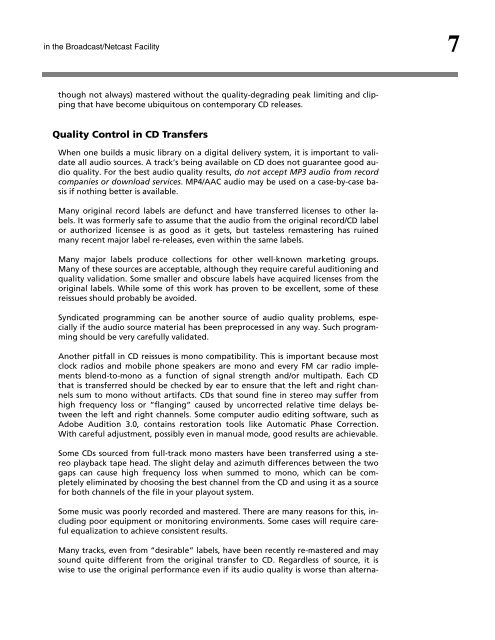Maintaining Audio Quality in the Broadcast Facility 2011 - Orban
Maintaining Audio Quality in the Broadcast Facility 2011 - Orban
Maintaining Audio Quality in the Broadcast Facility 2011 - Orban
Create successful ePaper yourself
Turn your PDF publications into a flip-book with our unique Google optimized e-Paper software.
<strong>in</strong> <strong>the</strong> <strong>Broadcast</strong>/Netcast <strong>Facility</strong> 7<br />
though not always) mastered without <strong>the</strong> quality-degrad<strong>in</strong>g peak limit<strong>in</strong>g and clipp<strong>in</strong>g<br />
that have become ubiquitous on contemporary CD releases.<br />
<strong>Quality</strong> Control <strong>in</strong> CD Transfers<br />
When one builds a music library on a digital delivery system, it is important to validate<br />
all audio sources. A track’s be<strong>in</strong>g available on CD does not guarantee good audio<br />
quality. For <strong>the</strong> best audio quality results, do not accept MP3 audio from record<br />
companies or download services. MP4/AAC audio may be used on a case-by-case basis<br />
if noth<strong>in</strong>g better is available.<br />
Many orig<strong>in</strong>al record labels are defunct and have transferred licenses to o<strong>the</strong>r labels.<br />
It was formerly safe to assume that <strong>the</strong> audio from <strong>the</strong> orig<strong>in</strong>al record/CD label<br />
or authorized licensee is as good as it gets, but tasteless remaster<strong>in</strong>g has ru<strong>in</strong>ed<br />
many recent major label re-releases, even with<strong>in</strong> <strong>the</strong> same labels.<br />
Many major labels produce collections for o<strong>the</strong>r well-known market<strong>in</strong>g groups.<br />
Many of <strong>the</strong>se sources are acceptable, although <strong>the</strong>y require careful audition<strong>in</strong>g and<br />
quality validation. Some smaller and obscure labels have acquired licenses from <strong>the</strong><br />
orig<strong>in</strong>al labels. While some of this work has proven to be excellent, some of <strong>the</strong>se<br />
reissues should probably be avoided.<br />
Syndicated programm<strong>in</strong>g can be ano<strong>the</strong>r source of audio quality problems, especially<br />
if <strong>the</strong> audio source material has been preprocessed <strong>in</strong> any way. Such programm<strong>in</strong>g<br />
should be very carefully validated.<br />
Ano<strong>the</strong>r pitfall <strong>in</strong> CD reissues is mono compatibility. This is important because most<br />
clock radios and mobile phone speakers are mono and every FM car radio implements<br />
blend-to-mono as a function of signal strength and/or multipath. Each CD<br />
that is transferred should be checked by ear to ensure that <strong>the</strong> left and right channels<br />
sum to mono without artifacts. CDs that sound f<strong>in</strong>e <strong>in</strong> stereo may suffer from<br />
high frequency loss or “flang<strong>in</strong>g” caused by uncorrected relative time delays between<br />
<strong>the</strong> left and right channels. Some computer audio edit<strong>in</strong>g software, such as<br />
Adobe Audition 3.0, conta<strong>in</strong>s restoration tools like Automatic Phase Correction.<br />
With careful adjustment, possibly even <strong>in</strong> manual mode, good results are achievable.<br />
Some CDs sourced from full-track mono masters have been transferred us<strong>in</strong>g a stereo<br />
playback tape head. The slight delay and azimuth differences between <strong>the</strong> two<br />
gaps can cause high frequency loss when summed to mono, which can be completely<br />
elim<strong>in</strong>ated by choos<strong>in</strong>g <strong>the</strong> best channel from <strong>the</strong> CD and us<strong>in</strong>g it as a source<br />
for both channels of <strong>the</strong> file <strong>in</strong> your playout system.<br />
Some music was poorly recorded and mastered. There are many reasons for this, <strong>in</strong>clud<strong>in</strong>g<br />
poor equipment or monitor<strong>in</strong>g environments. Some cases will require careful<br />
equalization to achieve consistent results.<br />
Many tracks, even from “desirable” labels, have been recently re-mastered and may<br />
sound quite different from <strong>the</strong> orig<strong>in</strong>al transfer to CD. Regardless of source, it is<br />
wise to use <strong>the</strong> orig<strong>in</strong>al performance even if its audio quality is worse than alterna-



![[PDF] Using the ITU BS.1770-2 and CBS Loudness Meters ... - Orban](https://img.yumpu.com/50629372/1/190x245/pdf-using-the-itu-bs1770-2-and-cbs-loudness-meters-orban.jpg?quality=85)






![[PDF] Optimod-FM Feature Comparison - Orban](https://img.yumpu.com/41741615/1/190x245/pdf-optimod-fm-feature-comparison-orban.jpg?quality=85)






